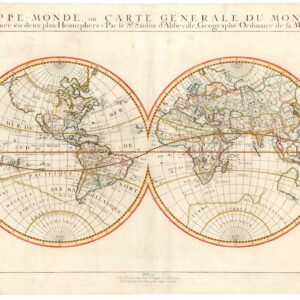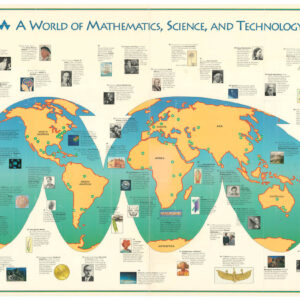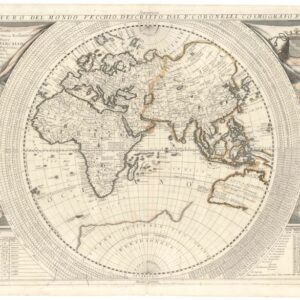Lovely 1752 world map with references to the mythical island of Atlantis and a bearded Chronos.
Orbis Vetus in utraque continente juxta mentem Sansonianam distinctus, nec non observationibus astonimicis redactus.
Out of stock
Description
Connecting the Americas to Atlantis
Gorgeous mid-18th century world map published in Paris representing a juxtaposition between modern cartographic theories and geographic notions linked with Classical Greece and Rome. More specifically, the map focuses much of its attention on the mythical lost island of Atlantis. The mapmaker has positioned within the map excerpts of famous texts from Antiquity, including several from Plato that discuss Atlantis.
Furthermore, a long Latin Monitum (notice or advisory) at bottom center of the chart discusses a possible association between the Americas and Atlantis; to understand this connection, it is important to remember that North and South America were conceived of spatially as islands separating the Atlantic and Pacific Oceans. In this context, the mapmaker’s reasoning is revealed. A link between Antiquity and the Enlightenment, between old and new, is perhaps further emphasized by a massive illustration in the title cartouche of an old bearded angel holding a scythe, who represents Chronos (or Father Time), and symbolizes the passage of time.
The map was compiled by Didier Robert de Vaugondy, based on the work of important Paris-based cartographer Guillaume Sanson. The high standards of 18th century French cartography have been applied to this chart, and complementing its Classical theme are some very up-to-date contemporary notions concerning world geography. One of the more interesting features is the misshapen and misunderstood Australia, with a speculative coastline that connects Papua New Guinea, New Zealand, and Australia to each other. The historical context for this fascinating error is that the map was produced in the time period after the early Dutch voyages of exploration in the region but before Captain James Cook’s famous expeditions, which helped bring the geography of this area to light. Similarly, the Pacific Northwest, its relationship to Asia, and the potential for a Northern Passage, all remain shrouded in darkness: blank spaces on an exciting map.
Cartographer(s):
Didier Robert de Vaugondy (1723 – 1786) was an 18th-century French geographer.
The son of Robert de Vaugondy, he was appointed geographer of the King by Louis XV, geographer of the Duke of Lorraine by Stanisław Leszczyński, King of Poland, Grand Duke of Lithuania, Duke of Lorraine. In 1773, he became royal censor for works related to geography, navigation, and travels.
Condition Description
An excellent example with minor discoloration.
References



